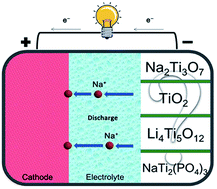Nanostructured Ti-based anode materials for Na-ion batteries
Abstract
With the shortage of fossil energy and global climate change, renewable energy sources offer the most promising solutions to these challenges. However, the intermittence of energy sources such as solar and wind requires sustainable energy storage technologies. Nowadays, electrochemical energy storage technologies and applications have attracted much attention, including portable electric devices, electric vehicles and smart power grids. Lithium-ion batteries (LIBs) have been widely applied in these areas because of their safety, portability and high energy density. Nevertheless, the resources of lithium are limited and the vast consumption of lithium has pushed up the price of lithium compounds, urging people to search for resourceful materials. Sodium can be a promising alternative due to its high abundance and low cost. Furthermore, titanium-based materials have become a hot spot for anode materials in sodium-ion batteries (SIBs), with their advantages of high safety and structural stability. In this review, we summarize the recent advances in Ti-based anode materials for SIB applications. We highlight the design and engineering of Ti-based nanoarchitectures, especially emphasizing the effective enhancement in performance and the related sodium storage mechanism.


 Please wait while we load your content...
Please wait while we load your content...